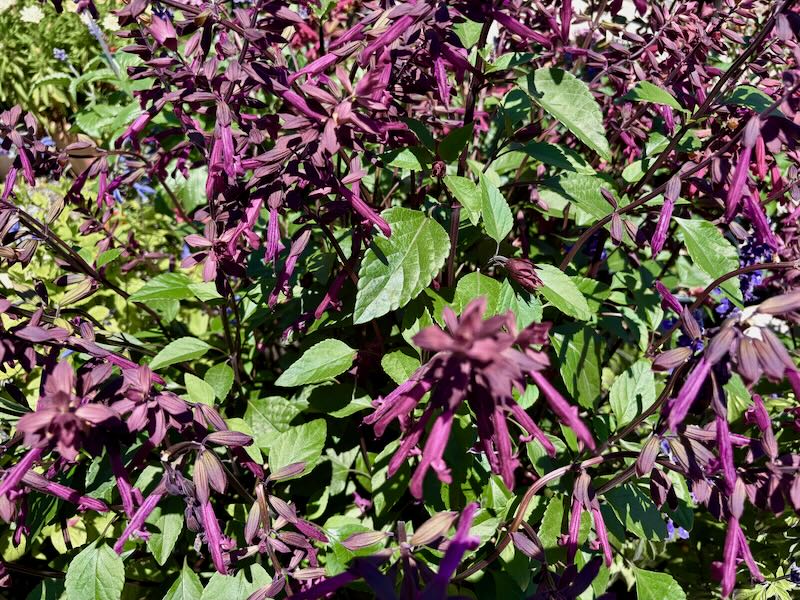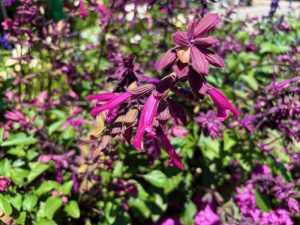Salvia ‘Skyscraper™ Dark Purple’: tall spires, nonstop bloom, compact habit
Salvia ‘Skyscraper™ Dark Purple‘ delivers saturated, deep purple flower spires from late spring to frost on a compact, well-branched plant that thrives in heat and sun. Gardeners know it by several common names—Skyscraper™ Dark Purple Salvia, Skyscraper™ Dark Purple Sage, Ornamental Sage, and Flowering Sage—and prize it for reliable color in borders, pots, and pollinator plantings.
As a member of the Mint Family (Lamiaceae), it carries the classic square stems, aromatic foliage, and nectar-rich blooms that bees, butterflies, and hummingbirds find irresistible. Unlike many tall salvias that outgrow tight spaces, this cultivar stays trim, usually 35–70 cm tall (14–28 in) and 25–40 cm wide (10–16 in), yet still sends up bold, showy flower spikes that read from across the garden.
Salvia ‘Skyscraper™ Dark Purple’ at a glance
This hybrid sage was selected for long bloom, sturdy stems, and strong heat tolerance. In mild-winter climates Salvia ‘Skyscraper™ Dark Purple’ performs as a short-lived perennial; elsewhere gardeners treat it as an annual workhorse for summer impact. The color is a rich purple with a wine-red cast in certain lights. Dusky calyces deepen the effect, so even before a new flush opens, the stems look dramatic.
Dense basal foliage forms a glossy, dark green clump that stays neat without heavy pruning. Because the plant keeps producing new spikes as you clip spent ones, it fits any high-traffic spot where you want a steady show: by a mailbox, along a sunny path, in a patio pot, or framing a small seating area.
The story and names behind Salvia ‘Skyscraper™ Dark Purple‘
Breeders developed the Skyscraper™ series for compact height with “tall-plant presence”—think stout stems and elongated spikes without the sprawling base. In the trade you may see the code Salvia × ‘HYBSV16016’ associated with this selection. Retail tags often shorten the name to Skyscraper™ Dark Purple Salvia or Skyscraper™ Dark Purple Sage. Whatever the tag says, you are buying a modern hybrid designed to flower hard, branch well, and look fresh even in summer heat.
Salvia ‘Skyscraper™ Dark Purple’ appearance and habit
Each plant builds a dense mound of lanceolate, mid- to dark-green leaves. The leaves feel slightly textured and release a light, pleasant scent when brushed. From this mound, upright flower stems rise 35–70 cm (14–28 in) and hold dense whorls of tubular blossoms. The flowers themselves range from velvety purple to purple-red depending on light and temperature. Since the calyces are also colored, finished spikes continue to look decorative for weeks. The overall habit is upright and tidy rather than sprawling, so you can tuck it into small beds or narrow borders without crowding neighbors.
Flowering season and color impact
Expect bloom from spring into autumn in most gardens. In warm regions, the display can begin in late spring and continue until frost. The plant produces in flushes; each time you remove the spent spikes, new shoots form below and race upward. Because the calyces carry deep color, the plants never look “green” between cycles. For continuous display, deadhead lightly every 7–10 days in peak season. In cooler areas, a single midseason haircut triggers a second wave as summer warms.
Environmental tolerances that make it easy
Heat does not faze this selection. It tolerates reflected heat near pavement and performs through hot, humid summers when many annuals stall. Once established in the ground, it endures short dry spells; in containers it appreciates regular water but dislikes soggy soil. Rabbits usually leave the aromatic foliage alone, and deer browsing tends to be light compared with more palatable plants. Full sun fuels the heaviest bloom, though morning sun with bright afternoon shade helps in scorching inland sites.
How to Grow Salvia ‘Skyscraper™ Dark Purple‘
Light
Place Salvia ‘Skyscraper™ Dark Purple’ in full sun for best performance. Aim for at least 6 hours of direct light daily. In very hot climates, give it morning sun and a touch of dappled afternoon shade. Too much shade stretches stems and reduces flower count, so err on the sunny side.
Soil
Set Salvia ‘Skyscraper™ Dark Purple’ in average, well-drained soil. This salvia hates wet feet. On clay, loosen the planting area 30–40 cm deep (12–16 in) and mix in coarse compost and fine bark to improve structure and drainage. On sand, add compost to boost moisture retention. A pH between 6.0 and 7.5 works well. For containers, choose a high-quality potting mix with added perlite or fine bark for airflow.
Watering
Water newly planted salvias deeply to settle the soil. During the first 2–3 weeks, keep the root zone evenly moist—not soggy—as roots expand. After establishment, allow the top 2–5 cm (1–2 in) of soil to dry before watering again. In the ground, that often means a thorough soak once or twice a week in summer heat; in pots, check daily and water when the surface feels dry. Always aim the water at the base to keep leaves dry and reduce disease pressure.
Fertilizing
Feed lightly. Too much nitrogen makes soft growth and fewer flowers. At planting, blend 2–3 cm (¾–1¼ in) of compost into the topsoil. In containers, incorporate a slow-release fertilizer per label directions. In the ground, a light topdress of compost in late spring is often enough. If repeat bloom slows, side-dress with a balanced, slow-release fertilizer or give a midseason sip of liquid bloom booster. Stop feeding 6–8 weeks before your first expected frost.
Temperature and hardiness
Treat Salvia ‘Skyscraper™ Dark Purple’ as a tender perennial. In mild-winter zones, it may overwinter and flower again after a spring cutback. In cold-winter climates, grow it as an annual or overwinter rooted cuttings indoors. Frost blackens top growth, so protect plants if temperatures dip near freezing (0°C / 32°F). Where winters stay above freezing, a light mulch keeps roots moderated through cool spells.
Pruning and deadheading
Clip spent spikes just above a strong set of leaves. New shoots break below the cut and rush to flower. If the plant looks tired in midsummer, cut the whole mound back by about one-third. Water well, feed lightly, and expect a fresh flush in 2–3 weeks. In frost-free regions, give a harder cut in late winter to remove old, woody stems and encourage dense new growth.
Mulching
Mulch a 45–60 cm circle (18–24 in) around each plant with 5–7 cm (2–3 in) of shredded bark or compost. Mulch conserves moisture, cools roots in heat, and keeps soil from splashing onto lower leaves. Pull mulch back a few centimeters from stems to prevent rot.
Spacing and air flow
Space Salvia ‘Skyscraper™ Dark Purple’ 30–40 cm apart (12–16 in) so air can move through the canopy. Good circulation helps foliage dry quickly after rain or irrigation and keeps common leaf spots at bay. In mixed planters, avoid cramming other spillers directly against the salvia’s base.
Containers
Use a pot at least 30–35 cm wide (12–14 in) with large drainage holes. Combine with upright grasses, sun coleus, and trailing lantana. In very hot weather, water daily or even twice daily for small pots. Fertilize containers more often than in-ground plantings; a light liquid feed every 2–3 weeks during peak bloom keeps the show rolling.
Propagation of Salvia ‘Skyscraper™ Dark Purple‘
Vegetative propagation preserves the exact flower color and habit. Take 7–10 cm (3–4 in) tip cuttings from non-flowering shoots in late spring or summer. Strip lower leaves, dip in a low-dose rooting hormone, and stick into a sterile 1:1 perlite and peat (or fine bark) mix. Keep bright, humid, and just moist until rooted. Many named salvias are protected by plant patent or breeder’s rights; check your local tag or supplier information before you propagate. Seed, if available, will not come true.
Pests and diseases: prevention first
Healthy, sun-grown plants in well-drained soil rarely suffer serious issues. Still, scout weekly so you can fix small problems fast.
Aphids sometimes cluster on tender shoots. A strong spray of water knocks them off. Follow with insecticidal soap if needed. Spider mites favor hot, dry conditions, especially on container plants; keep pots watered, and rinse foliage in the morning to disrupt mites. Whiteflies may hover if plants sit crowded in still air; increase spacing and use yellow sticky cards to monitor. Slugs or snails can nick lower leaves in wet spells; hand-pick at dusk or use barriers.
Fungal leaf spots or gray mold appear when leaves stay wet or air flow is poor. Water the soil, not the foliage. Thin nearby plants to lift humidity. Remove the worst-hit leaves, and if conditions stay wet, consider a labeled fungicide as a last resort. Root rot signals chronically wet soil; fix drainage or move the plant to a better site.
Salvia ‘Skyscraper™ Dark Purple’ in design
Use Salvia ‘Skyscraper™ Dark Purple’ where you want color at eye level without sacrificing space. In borders, repeat clumps every 60–90 cm (24–36 in) to create rhythm from May to frost. Mix with heat lovers that echo or contrast the purple: Blanket Flower (Gaillardia), Black-Eyed Susan (Rudbeckia), Coneflower (Echinacea), and Yarrow (Achillea) all provide complementary hues and matching sun needs. For a cool palette, flank it with Russian Sage (Perovskia atriplicifolia), Catmint (Nepeta), and blue Salvia like ‘Mystic Spires’. In contemporary gardens, mass three to five plants amid fine-textured grasses such as Maiden Grass (Miscanthus) to juxtapose vertical bloom spikes with airy plumes. In pots, make it the “thriller” with trailing calibrachoa or lantana spilling over the rim.
Wildlife value and sustainability
Pollinators find this plant quickly. The long, tubular blossoms feed bees and butterflies through summer droughts and hot spells when nectar can run scarce elsewhere. Hummingbirds work the spikes methodically, returning daily when you maintain bloom with deadheading. Because established plants tolerate brief dryness, you can water deeply but less often, saving water while keeping the show strong. The aromatic foliage also helps deter rabbits, reducing the need for repellents.
Seasonal care calendar
Early spring: In frost-free areas, cut back by about one-third to refresh the mound. In colder zones, plant nursery starts after the last frost when soil warms. Mulch and water to settle.
Late spring: Pinch very early shoots once to encourage bushiness if plants look leggy, then let flower spikes develop. Begin light feeding in containers.
Summer: Deadhead consistently. Water deeply when the top 2–5 cm (1–2 in) of soil dries. If the display lags, shear by one-third and feed lightly to trigger a new wave.
Early autumn: Continue deadheading to extend bloom. Reduce fertilizer as nights cool so growth can harden before frost.
Late autumn to winter: In mild climates, leave some old stems to shelter the crown, then tidy in late winter. In cold regions, take cuttings before frost if you want clones for next year, or plan to replant in spring.
Common mistakes and quick fixes
Planting in soggy soil leads to root trouble. If lower leaves yellow while soil stays wet, improve drainage or shift the plant to a raised bed or container. Starving a pot-grown salvia reduces bloom; give a light, regular feed. Skipping deadheading shortens the show; clip spikes as soon as they fade. Crowding reduces airflow; space plants and trim nearby neighbors. Planting in deep shade stretches stems; move to a sunnier spot for stocky growth and more spikes.
Frequently asked questions
Will Salvia ‘Skyscraper™ Dark Purple’ survive winter in my zone?
In mild-winter regions it can behave as a perennial and return after a spring cutback. In cold-winter climates, treat it as an annual or overwinter cuttings indoors under bright light.
Does it need staking?
No. Sturdy stems hold spikes upright even in wind. If plants stretch in shade, move them to stronger light rather than stake.
Is it safe around pets?
Salvia foliage is generally considered low-toxicity and often unpalatable. Still, discourage chewing and consult your veterinarian for species-specific guidance.
Can I grow it in partial sun?
Yes, especially in hot regions. Aim for morning sun plus bright light the rest of the day. With less than 6 hours of direct sun, expect fewer flowers.
Final take
Plant Salvia ‘Skyscraper™ Dark Purple’ in full sun and well-drained soil, water when the top few centimeters of soil dry, and clip spent spikes to keep flowers coming. Feed lightly, give it space to breathe, and let heat work in your favor. Whether you line a walk, dot a border, or stage a container, this compact sage earns its keep with months of saturated color, tidy growth, and steady pollinator traffic—all in a footprint small gardens can spare.



